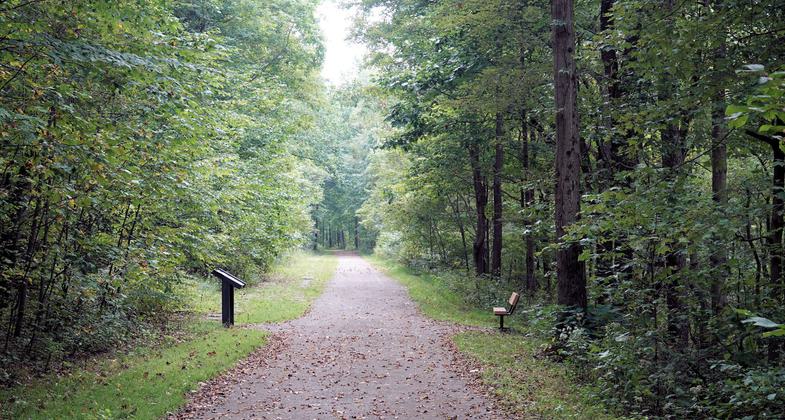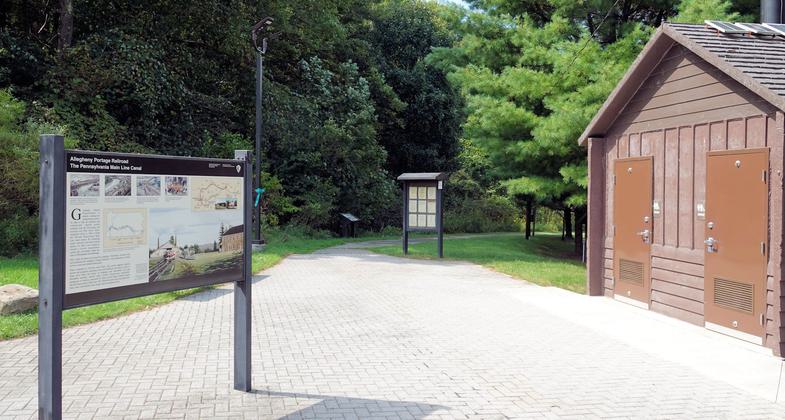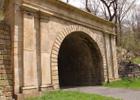Staple Bend Tunnel Trail
check with the trail manager for updated details before visiting.
Staple Bend Tunnel Trail
National Park Service
Backcountry Trail
Frontcountry Trail
Rail Trail
Urban Trail
- Length
2.5 miles
- Elevation Gain
--
- Route Type
out & back
(1 review)
- Length
2.5 miles - Elevation Gain
-- - Route Type
out & back
The Staple Bend Tunnel Trail follows the path of the Allegheny Portage Railroad to the first railroad tunnel in the country, the 901-foot-long Staple Bend Tunnel. The railroad, an engineering landmark, lifted canal boats over the Allegheny Mountains in the 1830s, '40s, and '50s. This trail, Managed by the National Park Service, allows the visitor to walk or bike to the nation's first railroad tunnel.

Western portal of the Staple Bend Tunnel.

Staple Bend Tunnel Trail - typical section of the trail between the trailhead and the tunnel. Photo by Jim Walla.

Staple Bend Tunnel Trail - trailhead. Photo by Jim Walla.

Eastern portal of the Staple Bend Tunnel.
Location: Mineral Point, PA
- States: Pennsylvania
- Counties: Cambria
- Cities/Townships: Conemaugh Twp.
The Staple Bend Tunnel Trail follows the path of the Allegheny Portage Railroad to the first railroad tunnel in the country, the 901-foot-long Staple Bend Tunnel. The railroad, an engineering landmark, lifted canal boats over the Allegheny Mountains in the 1830s, '40s, and '50s. This trail, Managed by the National Park Service, allows the visitor to walk or bike to the nation's first railroad tunnel.
Included as part of the Path of the Flood NRT, the Staple Bend Tunnel trail is one segment of the Pittsburgh to Harrisburg Main Line Canal Greenway. The trail has two surfaces that will serve two populations. The 2.5-mile trail is level with a limestone surface that caters to recreational exercise. The trail also is the only access to the Staple Bend Tunnel, a unique tunnel with exemplary stone masonry and exposed rock.
This trail has several features that set it apart from any rail trail in the world. First and foremost is Staple Bend Tunnel, the first railroad tunnel completed in America. It was the third tunnel of any kind built in the U.S., the first tunnels were for other canals in Pennsylvania. Work began on the tunnel on November 21, 1831, and often occurred during inclement conditions. The men were paid $13 per month plus room and board for 12-hour days 6 days per week. Workers chipped and blasted 901 feet of solid rock to make the tunnel.
Approximately 14,900 cubic yards of bedrock were removed using black powder blasting. This was done by drilling three feet long holes and packing them with powder. Drilling one typical hole took up to three hours of hard effort using a three-man crew. Nine to ten holes, each one inch in diameter and thirty-six inches in length were made before blasting. One pound of explosive powder wrapped in paper was pushed into each hole, tamped down, punctured with a sharp needle, and a fuse added. Fuses were lit with explosions to occur at mealtime. Workers would eat while the dust settled then get to work cleaning (mucking) the tunnel. Of the 36-inch hole drilled only 18 inches, or half of the hole, was blasted.
The tunnel grew about 18 inches each day, with both sides moving toward the center. On December 21, 1832, the workmen broke through the final barrier and connected the two ends of the tunnel. There was much celebration with speeches and toasts. The full tunnel excavation was completed in April 1833.
The ends of the Staple Bend Tunnel were lined with cut stone for safety. Rock and dirt might fall due to rain or other weather, or from the effects of the portage railroad going through the tunnel. The fancy entranceways to the tunnel were to impress the travelers and the general public. The style was described as a Roman Revival style with low relief lintel supported by Doric pilasters on each side. Of the money spent (the total cost was $37,498.85), nearly half was to build the entranceways.
The mark (signature) from the early 19th century stonecutters can still be seen on several blocks (bring a flashlight). The rest of the tunnel is natural bare rock.
Along the trail are several rows of existing stone sleepers used as railroad ties in the 1800s. Once through the tunnel, you are standing at the top of the first of a series of 10 inclines used to transport canal boats loaded on rail cars across the Allegheny Mountains, connecting Philadelphia and Pittsburgh and beyond. The Staple Bend Tunnel Trail is part of a larger trail system known as the Path of the Flood Trail, which follows the route of the 1889 Johnstown Flood from South Fork to Johnstown along the Little Conemaugh River.
Accessibility Information
No text provided.
Reviews
Mark
My day trip back in time
Amazing what an effort. The labor it took to construct by hand and to cut out of stone the rail road ties used. As I walked along this old railroad bed viewing below the trains that are still using this same area to cut through the mountains.
Allowed Uses:
Bicycling Dogs, on leash Hiking/Walking Snow, cross-country skiingOther Activities
- Snow, snow play general
- Wildlife viewing / observation
Public Contact
Keith NewlinNational Park Service
l10 Federal Park Drive
Gallitzin, PA 16641
[email protected] • (814) 886-6121
www.nps.gov/alpo
Contact the trail manager for current maps and visiting details.
More Details
- Elevation (low): --
- Elevation (high): --
- Elevation (cumulative): --
- Part of a Trail System? No
- National Designations: Millenium Legacy Trail
- Surface (primary): Rock, crushed
- Surfaces (additional): Grass or Vegetation, Rock, crushed, Snow or ice
- Tread Width (average): 0"
- Tread Width (minimum): --
- Running length (minimum): --
- Tread Grade (average, percent): 1
- Tread Grade (maximum): 1
- Running length (maximum): --
- Cross-slope (average, percent): --
- Cross-slope (maximum): --
- Running length (maximum): --
- Certified as an NRT
May 25, 2009

